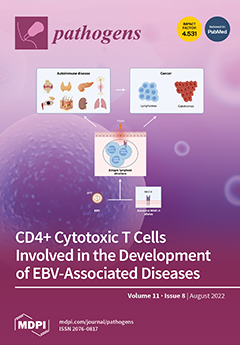Ticks are hematophagous ectoparasites that are capable of infesting a wide range of mammals, including domestic animals, ruminants, wildlife, and humans across the world, and they transmit disease-causing pathogens. Numerous individual epidemiological studies have been conducted on the distribution and prevalence of ticks
[...] Read more.
Ticks are hematophagous ectoparasites that are capable of infesting a wide range of mammals, including domestic animals, ruminants, wildlife, and humans across the world, and they transmit disease-causing pathogens. Numerous individual epidemiological studies have been conducted on the distribution and prevalence of ticks and tick-borne diseases (TBDs) in the Southern African Developing Community (SADC) region, but no effort has been undertaken to synchronize findings, which would be helpful in the implementation of consolidated tick control measures. With the aim of generating consolidated pooled prevalence estimates of ticks and TBDs in the SADC region, we performed a systematic review and meta-analysis of published articles using the PRISMA 2020 guidelines. A deep search was performed on five electronic databases, namely, PubMed, ScienceDirect, Google Scholar, AJOL, and Springer Link. Of the 347 articles identified, only 61 of the articles were eligible for inclusion. In total, 18,355 tick specimens were collected, belonging to the genera
Amblyomma,
Haemaphysalis,
Hyalomma, and
Rhipicephalus (including
Boophilus) across several countries, including South Africa (n = 8), Tanzania (n = 3), Zambia (n = 2), Zimbabwe (n = 2), Madagascar (n = 2), Angola (n = 2), Mozambique (n = 1), and Comoros (n = 1). The overall pooled prevalence estimate (PPE) of TBPs in livestock was 52.2%, with the highest PPE in cattle [51.2%], followed by sheep [45.4%], and goats [29.9%]. For bacteria-like and rickettsial TBPs,
Anaplasma marginale had the highest PPE of 45.9%, followed by
A. centrale [14.7%],
A. phagocytophilum [2.52%], and
A. bovis [0.88%], whilst
Ehrlichia ruminantium had a PPE of 4.2%. For piroplasmids,
Babesia bigemina and
B. bovis had PPEs of 20.8% and 20.3%, respectively.
Theileria velifera had the highest PPE of 43.0%, followed by
T. mutans [29.1%],
T. parva [25.0%], and other
Theileria spp. [14.06%]. Findings from this study suggest the need for a consolidated scientific approach in the investigation of ticks, TBPs, and TBDs in the whole SADC region, as most of the TBDs are transboundary and require a regional control strategy.
Full article






